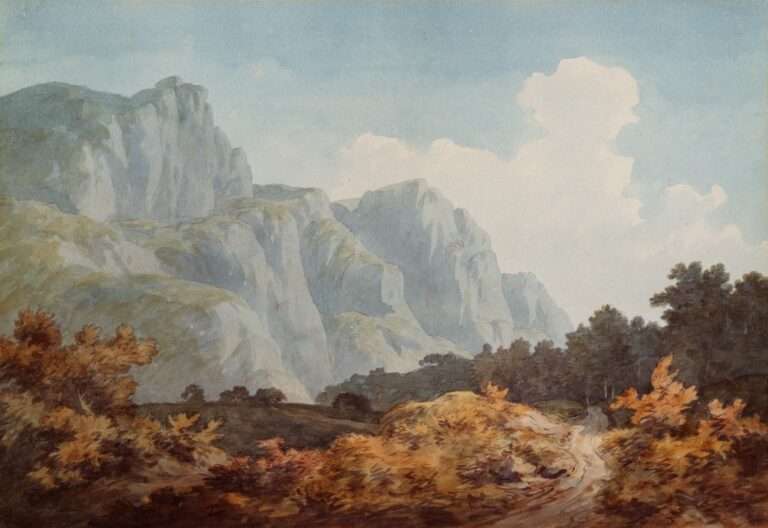Emotional Depths of Art: Expressionism and Symbolism
Expressionism and Symbolism are two influential art movements that emerged in the late 19th and early 20th centuries. Both movements sought to explore the inner world of emotions and subjective experiences, but they did so in different ways. Expressionism focused on the expression of intense emotions through distorted forms and exaggerated colors, while Symbolism used symbols and metaphors to convey deeper meanings. These movements were a response to the changing social and political climate of the time, as well as a rejection of traditional artistic conventions.
Expressionism emerged in Germany in the early 20th century as a response to the rapid industrialization and urbanization that was taking place. Artists sought to express their inner turmoil and anxiety through their work, often using bold colors and exaggerated forms to convey intense emotions. Symbolism, on the other hand, originated in France in the late 19th century as a reaction against the rationality and materialism of the Industrial Revolution. Symbolist artists sought to explore the mystical and spiritual aspects of life through symbols and metaphors.
The Role of Emotions in Artistic Expression
Emotions have always played a central role in artistic expression. Artists use their work as a means of communicating their innermost thoughts and feelings, often using visual elements such as color, form, and composition to evoke specific emotions in viewers. In Expressionism and Symbolism, emotions are not only expressed but also amplified and intensified.
In Expressionism, artists sought to convey their own subjective experiences and emotions through their work. They used bold colors, exaggerated forms, and distorted perspectives to create a sense of unease or intensity. The aim was not to depict reality as it appears but rather to express the emotional reality of the artist.
Symbolist artists, on the other hand, used symbols and metaphors to convey deeper meanings and emotions. They believed that art should be a reflection of the artist’s inner world and sought to express their dreams, fantasies, and subconscious thoughts through their work. Symbolism often relied on suggestive and ambiguous imagery, allowing viewers to interpret the work in their own way and evoke their own emotions.
The Historical Context of Expressionism and Symbolism
The emergence of Expressionism and Symbolism was closely tied to the social and political climate of the time. In the early 20th century, Germany was undergoing significant changes due to industrialization and urbanization. This rapid transformation led to a sense of alienation and anxiety among many artists, who sought to express these feelings through their work.
Symbolism, on the other hand, emerged in France as a reaction against the rationality and materialism of the Industrial Revolution. Symbolist artists rejected the idea that art should simply imitate reality and instead sought to explore the mystical and spiritual aspects of life. They believed that art should be a means of transcending the material world and connecting with something deeper.
Both movements were also influenced by other art movements of the time. Expressionism was influenced by the Fauvist movement, which also used bold colors and exaggerated forms to convey emotions. Symbolism, on the other hand, was influenced by the Pre-Raphaelite Brotherhood in England, which sought to revive the spiritual and symbolic aspects of art.
Key Characteristics of Expressionist and Symbolist Art
Expressionist art is characterized by its use of bold colors, exaggerated forms, and distorted perspectives. Artists sought to convey intense emotions through their work, often using vibrant colors such as reds, yellows, and blues to create a sense of energy or tension. Forms were often distorted or exaggerated to convey a sense of unease or intensity.
Symbolist art, on the other hand, is characterized by its use of symbols and metaphors to convey deeper meanings. Artists sought to explore the mystical and spiritual aspects of life, often using suggestive and ambiguous imagery to allow viewers to interpret the work in their own way. Symbolist art often relied on dreamlike or fantastical imagery, creating a sense of mystery or otherworldliness.
The Use of Color and Form in Expressionism and Symbolism
Color plays a significant role in both Expressionism and Symbolism. In Expressionism, color is used to convey intense emotions and create a sense of energy or tension. Artists often used bold, vibrant colors such as reds, yellows, and blues to evoke specific emotions in viewers. These colors were often applied in thick, gestural brushstrokes to create a sense of movement or intensity.
In Symbolism, color is used more symbolically to convey deeper meanings. Artists often used muted or symbolic colors to create a specific mood or atmosphere. For example, blue might be used to convey a sense of calm or spirituality, while red might be used to convey passion or intensity.
Form is also an important element in both movements. In Expressionism, forms are often distorted or exaggerated to convey a sense of unease or intensity. Artists sought to express their own subjective experiences and emotions through their work, often using distorted perspectives or exaggerated forms to create a sense of unease or intensity.
In Symbolism, form is used to convey emotions and deeper meanings. Artists often used suggestive and ambiguous forms to allow viewers to interpret the work in their own way. Forms were often stylized or simplified, creating a sense of mystery or otherworldliness.
The Relationship between Art and the Unconscious Mind

Both Expressionism and Symbolism were influenced by the ideas of Sigmund Freud and his theories on the unconscious mind. Freud believed that the unconscious mind played a significant role in shaping human behavior and that it could be accessed through dreams, fantasies, and art.
Expressionist artists sought to explore the unconscious mind through their work, using bold colors, distorted forms, and exaggerated perspectives to express their innermost thoughts and feelings. They believed that art should be a means of self-expression and self-discovery, allowing the artist to tap into their own unconscious mind.
Symbolist artists, on the other hand, used symbols and metaphors to explore the unconscious mind. They believed that art should be a reflection of the artist’s inner world and sought to express their dreams, fantasies, and subconscious thoughts through their work. Symbolism often relied on suggestive and ambiguous imagery, allowing viewers to interpret the work in their own way and evoke their own unconscious thoughts and emotions.
The Impact of Expressionism and Symbolism on Modern Art
Expressionism and Symbolism had a significant impact on modern art, influencing many subsequent art movements. Expressionism, in particular, had a profound influence on the development of abstract art. Artists such as Wassily Kandinsky and Franz Marc were inspired by Expressionism’s emphasis on emotion and subjective experience and sought to create art that was free from representational constraints.
Symbolism also had a lasting impact on modern art, particularly in its use of symbols and metaphors. Many artists were inspired by Symbolism’s exploration of the mystical and spiritual aspects of life and sought to incorporate these ideas into their own work. The use of symbols and metaphors became a central feature of many subsequent art movements, including Surrealism and Abstract Expressionism.
The Psychological Effects of Expressionist and Symbolist Art on Viewers
Expressionist and Symbolist art can have a profound psychological effect on viewers. The intense emotions expressed in these works can evoke strong emotional responses in viewers, often eliciting feelings of unease, tension, or intensity. This can lead to a heightened sense of self-awareness or introspection.
Viewing Expressionist or Symbolist art can also have therapeutic benefits. The intense emotions expressed in these works can provide a cathartic release for viewers, allowing them to process and express their own emotions. This can be particularly beneficial for individuals who struggle with emotional expression or have difficulty accessing their own unconscious thoughts and feelings.
The Intersection of Expressionism and Symbolism with Literature and Music
Expressionism and Symbolism are not limited to the visual arts but also intersect with literature and music. In literature, Expressionism is characterized by its use of intense emotions, fragmented narratives, and stream-of-consciousness writing. Writers such as Franz Kafka and Virginia Woolf were influenced by Expressionism’s emphasis on subjective experience and sought to capture the inner world of their characters.
Symbolism also had a significant impact on literature, particularly in its use of symbols and metaphors. Writers such as Charles Baudelaire and Arthur Rimbaud used symbolic imagery to convey deeper meanings and explore the mystical and spiritual aspects of life. Symbolist literature often relied on suggestive and ambiguous language, allowing readers to interpret the work in their own way.
In music, Expressionism is characterized by its use of dissonance, atonality, and unconventional forms. Composers such as Arnold Schoenberg and Alban Berg sought to express intense emotions through their music, often using dissonant harmonies and unconventional forms to create a sense of unease or intensity.
Symbolism also had an influence on music, particularly in its use of suggestive and ambiguous imagery. Composers such as Claude Debussy and Maurice Ravel used symbolic imagery in their compositions to create a specific mood or atmosphere. Symbolist music often relied on evocative melodies and rich harmonies to convey deeper meanings.
The Future of Expressionism and Symbolism in Art and Culture
Expressionism and Symbolism continue to be relevant in contemporary art and culture. Artists continue to explore the inner world of emotions and subjective experiences through their work, often using elements of Expressionism or Symbolism to convey their ideas. These movements have also influenced other art forms, such as literature and music, and continue to inspire new interpretations and applications.
In the future, we can expect to see new interpretations and applications of Expressionism and Symbolism in art and culture. As society continues to evolve, artists will continue to explore new ways of expressing their emotions and subjective experiences. The influence of Expressionism and Symbolism will likely continue to be felt in contemporary art, as artists seek to connect with their audience on a deeper emotional level.
If you’re interested in exploring the symbolism of celestial bodies in art, you might find this article on “What Does the Moon Symbolize?” fascinating. The moon has long been a subject of artistic interpretation, representing various themes such as femininity, intuition, and the subconscious mind. This article delves into the rich symbolism associated with the moon and its significance in different cultures and artistic movements. To learn more about the symbolism of the moon, check out this link.
FAQs
What is Expressionism Symbolism in Art?
Expressionism Symbolism in Art is a movement in art that emerged in the early 20th century. It is characterized by the use of symbols and exaggerated forms to express emotions and ideas.
What are the key features of Expressionism Symbolism in Art?
The key features of Expressionism Symbolism in Art include the use of bold colors, distorted forms, and exaggerated shapes to convey emotions and ideas. It also involves the use of symbols and metaphors to represent abstract concepts.
What are some famous examples of Expressionism Symbolism in Art?
Some famous examples of Expressionism Symbolism in Art include the works of Vincent van Gogh, Edvard Munch, and Gustav Klimt. These artists used bold colors, distorted forms, and exaggerated shapes to express their emotions and ideas.
What is the difference between Expressionism and Symbolism?
Expressionism and Symbolism are two different movements in art. Expressionism is characterized by the use of bold colors, distorted forms, and exaggerated shapes to express emotions and ideas. Symbolism, on the other hand, involves the use of symbols and metaphors to represent abstract concepts.
What is the significance of Expressionism Symbolism in Art?
Expressionism Symbolism in Art is significant because it represents a departure from traditional art forms and a move towards more abstract and emotional expressions. It also paved the way for other modern art movements, such as Surrealism and Abstract Expressionism.





